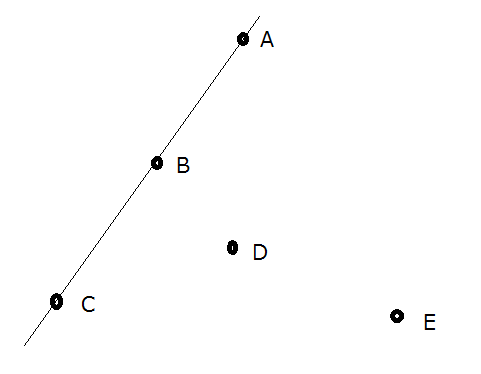E - ConvexScore 逆向思维+简单计算几何
题目传送门
Time limit : 2sec / Memory limit : 256MB
Score : 700 points
Problem Statement
You are given N points (xi,yi) located on a two-dimensional plane. Consider a subset S of the N points that forms a convex polygon. Here, we say a set of points S forms a convex polygon when there exists a convex polygon with a positive area that has the same set of vertices as S. All the interior angles of the polygon must be strictly less than 180°.

For example, in the figure above, {A,C,E} and {B,D,E} form convex polygons; {A,C,D,E}, {A,B,C,E}, {A,B,C}, {D,E} and {} do not.
For a given set S, let n be the number of the points among the N points that are inside the convex hull of S (including the boundary and vertices). Then, we will define the score of S as 2^(n−|S|).
Compute the scores of all possible sets S that form convex polygons, and find the sum of all those scores.
However, since the sum can be extremely large, print the sum modulo 998244353.
Constraints(约束,限制条件)
1≤N≤200
0≤xi,yi<104(1≤i≤N)
If i≠j, xi≠xj or yi≠yj.
xi and yi are integers.
Input
The input is given from Standard Input in the following format:
N
x1 y1
x2 y2
:
xN yN
Output
Print the sum of all the scores modulo 998244353.
Sample Input 1
4
0 0
0 1
1 0
1 1

Sample Output 1
5
We have five possible sets as S, four sets that form triangles and one set that forms a square. Each of them has a score of 20=1, so the answer is 5.
Sample Input 2
5
0 0
0 1
0 2
0 3
1 1
Sample Output 2
11
We have three “triangles” with a score of 1 each, two “triangles” with a score of 2 each, and one “triangle” with a score of 4. Thus, the answer is 11.
Sample Input 3
1
3141 2718
Sample Output 3
0
There are no possible set as S, so the answer is 0.
Solution
题意:平面上有n(n<=200)个点,对于其中能够构成凸多边形的点集S,计算一个得分score,并输出所有这样能构成凸多边形的点集的得分之和sigma(score)。score=2^(n-|S|), n: 构成此凸多边形的点数及其内部的点数总和;|S|: 构成此凸多边形的点数。
问题转化:
题目要求的score,对于一个凸多边形点集S来说,就是在已经选择了此凸多边形的情况下,里面的点任意选择的方案数;
即以此凸多边形为凸包的点集的总方案数;
而对于整道题目来说,就是给出n个点,求它们所能构成凸包的方案总数。但此时正着去想仍然不好做,总不能for (i=0:200)求C(200,i)呀!
逆向思维:
n个点一共有2^n个点集(好吧包括空集C(n,0)==1、单点集C(n,1)==1和必然共线的两点集C(n,2)…,无妨,稍后会在计算中减去它们),从这2^n个总方案里面减去不能构成凸包的方案数,即可更轻松地得到答案。因不能构成凸包的方案数很少,空集、单点、两点以及多个共线的点的时候。而求多点共线的方案就比较简单了:for/for/for,3层for循环大概8*10^6的复杂度,外层2道循环枚举不同的两点i,j,内循环枚举落在被i,j确定的那条直线上面的点,构成的点集有多少个点,则减去它们造成的不能构成凸包的方案数即可。注意细节。
Reflections
很喜欢高中数学老师甜甜的笑容和幽默而富有哲理的话儿,比如:
1.“做个题你还嫌麻烦,吃饭不麻烦呀,还得一口一口的吃?”
2.“正难则反。”
也回忆一番那段我们一起努力奋斗过的美好时光,还有那帮思维缜密高考数学能考满分或者理综280+290+的孩纸们
Code
#include <bits/stdc++.h>
#define ll long long
using namespace std;
const int N = 210;
const ll MOD = 998244353;
struct data{
int x,y;
}a[N];
int n,cnt;
ll ans;
int collinear(ll a,ll b,ll c,ll d) {
return a*d==b*c;
}
ll fun(ll a,ll k) {
if (k<0) return 0;
ll res = 1;
while (k) {
if (k&1) res = res*a%MOD;
a = a*a%MOD;
k>>=1;
}
return res;
}
int main() {
scanf("%d",&n);
for (int i=0;i<n;++i) scanf("%d%d",&a[i].x,&a[i].y);
ans = fun(2,n) - 1 - n;
(ans+=MOD)%=MOD;
for (int i=0;i<n-1;++i) {
for (int j=i+1;j<n;++j) {
cnt=0;
for (int k=j+1;k<n;++k)
cnt+=collinear(a[i].x - a[j].x,a[j].x - a[k].x,a[i].y - a[j].y,a[j].y - a[k].y);
(ans+=MOD - fun(2,cnt)) %= MOD;
}
}
printf("%lld\n",ans);
return 0;
}